- Home
- Expeditions
- Galápagos Rift Expedition 2011
- Mission Logs
- July 14
This expedition’s inaugural dive was on the Paramount Seamount, an underwater mountain with a summit less than 300m below the sea surface. We were able to characterize the biological communities on this seamount, and make some interesting comparisons with last year’s expedition to the Sangihe Talaud region in Indonesia.
Some of the unique fauna found at the Paramount Seamounts, taken on July 14th, 2011 during the Galapágos Rift Expedition.
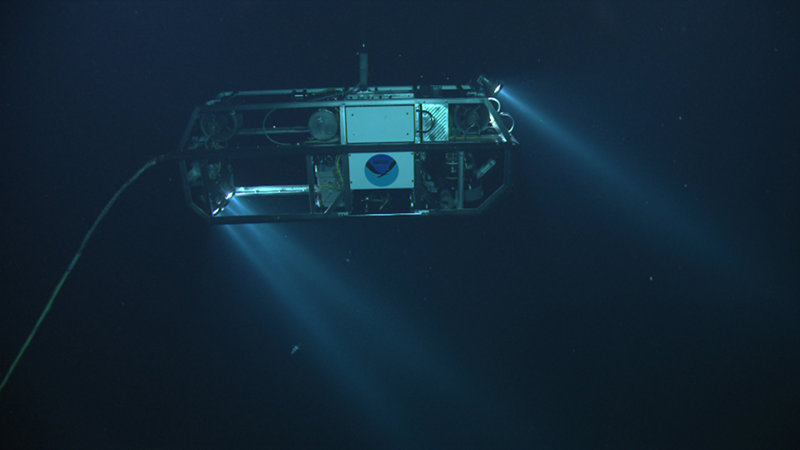
The HD camera on the Little Hercules is white-balanced on a panel attached to Seirios before the dive. Image captured by the Little Hercules ROV at 600 meters depth on the Paramount seamounts on July 14, 2011. Image courtesy of NOAA Office of Ocean Exploration and Research.
Download larger version (jpg, 907 KB).
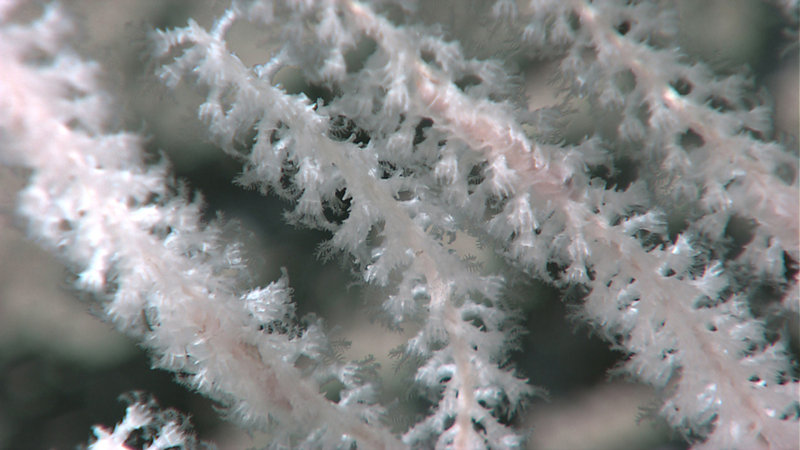
Close up on octocoral, likely a member of the family Primnoidae. Image captured by the Little Hercules ROV at 600 meters depth on the Paramount seamounts on July 14, 2011. Image courtesy of NOAA Office of Ocean Exploration and Research.
Download larger version (jpg, 1.2 MB).
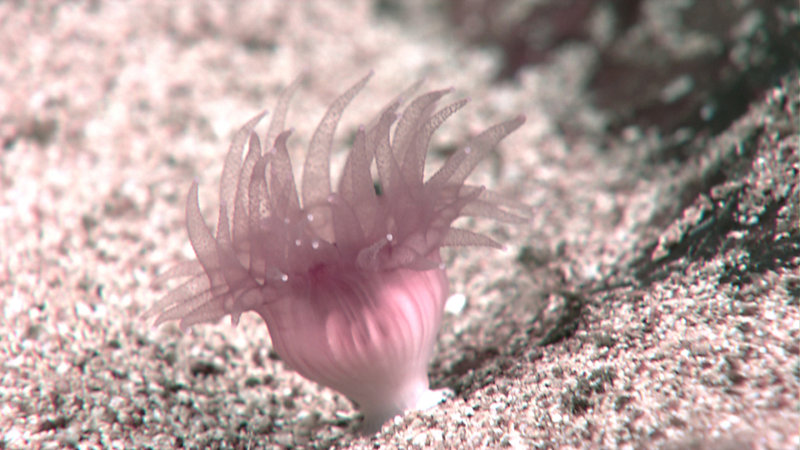
Solitary stony cup coral with tentacles extended in feeding position. Image captured by the Little Hercules ROV at 600 meters depth on the Paramount seamounts on July 14, 2011. Image courtesy of NOAA Office of Ocean Exploration and Research.
Download larger version (jpg, 1.3 MB).
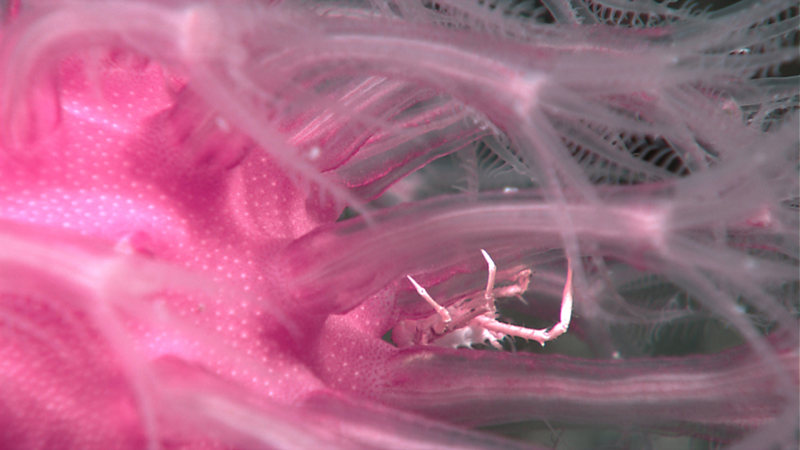
Galatheid squat lobster on an Anthomastus coral. Image captured by the Little Hercules ROV at 600 meters depth on the Paramount seamounts on July 14, 2011. Image courtesy of NOAA Office of Ocean Exploration and Research.
Download larger version (jpg, 1.1 MB).
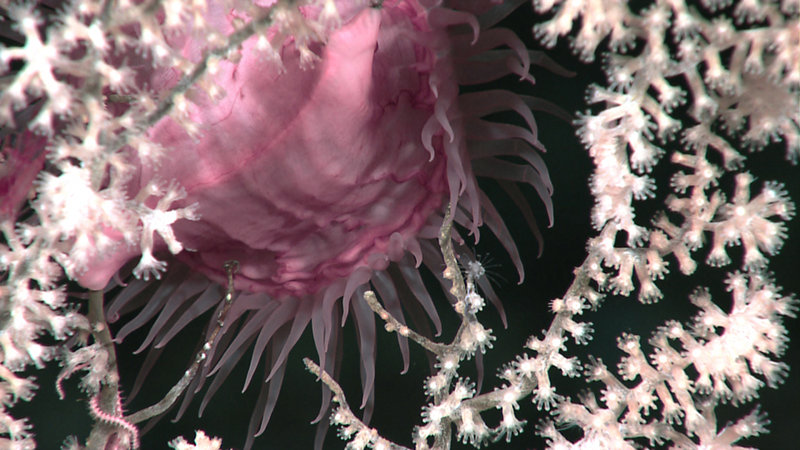
Anemone-octocoral symbiosis. Image captured by the Little Hercules ROV at 600 meters depth on the Paramount seamounts on July 14, 2011. Image courtesy of NOAA Office of Ocean Exploration and Research.
Download larger version (jpg, 1.3 MB).

Brachyuran crab holding what seems to be an egg case. Image captured by the Little Hercules ROV at 600 meters depth on the Paramount seamounts on July 14, 2011. Image courtesy of NOAA Office of Ocean Exploration and Research.
Download larger version (jpg, 1.4 MB).
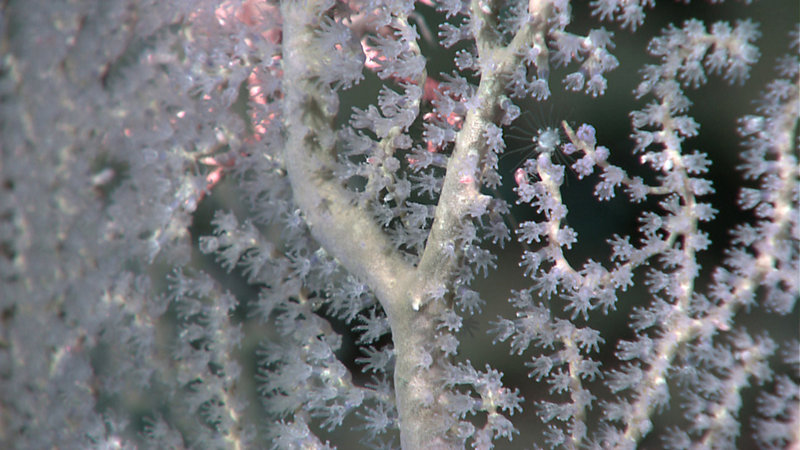
Crab-octocoral symbiosis. Image captured by the Little Hercules ROV at 600 meters depth on the Paramount seamounts on July 14, 2011. Image courtesy of NOAA Office of Ocean Exploration and Research.
Download larger version (jpg, 1.3 MB).
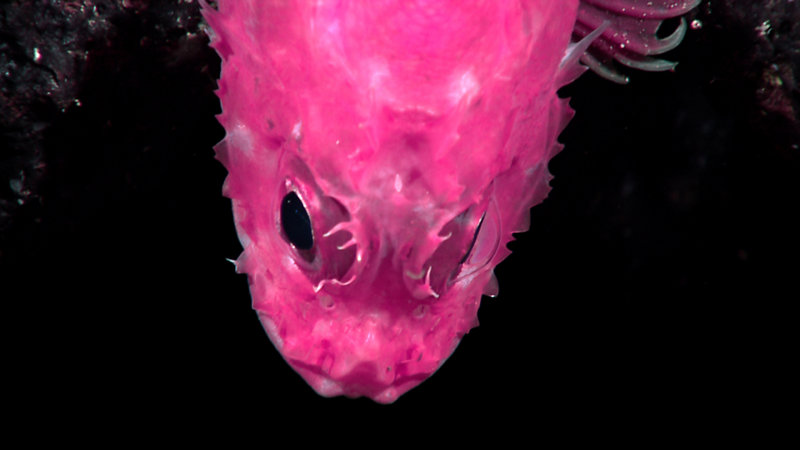
Close up on rockfish hanging on the side of boulder. Image captured by the Little Hercules ROV at 600 meters depth on the Paramount seamounts on July 14, 2011. Image courtesy of NOAA Office of Ocean Exploration and Research.
Download larger version (jpg, 689 KB).
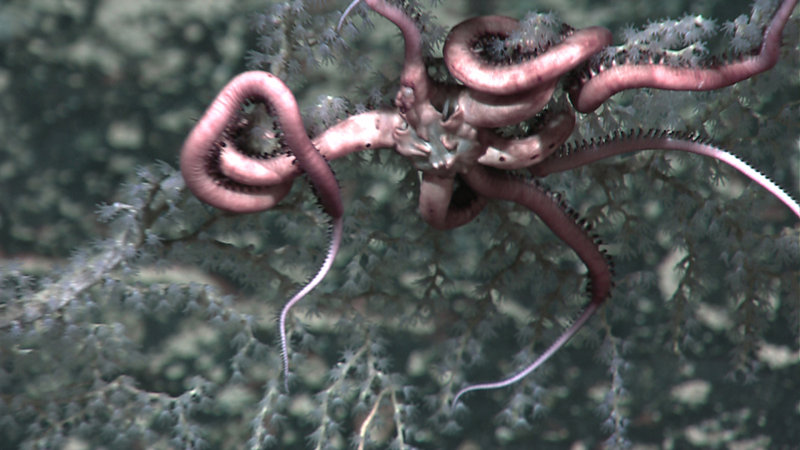
An ophiuroid (brittlestar) on a plexaurid coral. Image captured by the Little Hercules ROV at 600 meters depth on the Paramount seamounts on July 14, 2011. Image courtesy of NOAA Office of Ocean Exploration and Research.
Download larger version (jpg, 1.1 MB).
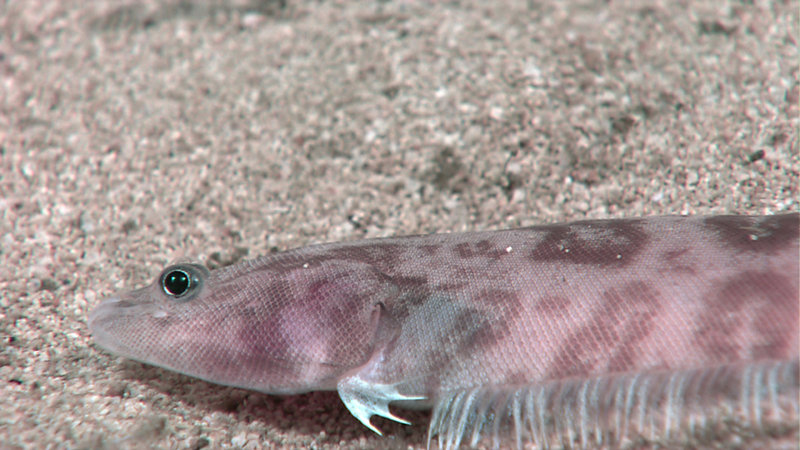
Deep-sea flat fish are well adapted to a benthic lifestyle. Image captured by the Little Hercules ROV at 600 meters depth on the Paramount seamounts on July 14, 2011. Image courtesy of NOAA Office of Ocean Exploration and Research.
Download larger version (jpg, 1.4 MB).
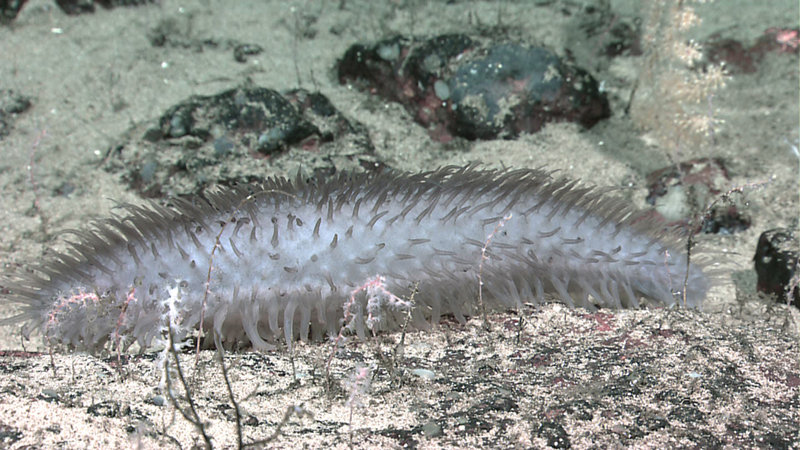
Holothurian sea cucumber feeding on sediments. Image captured by the Little Hercules ROV at 600 meters depth on the Paramount seamounts on July 14, 2011. Image courtesy of NOAA Office of Ocean Exploration and Research.
Download larger version (jpg, 1.5 MB).
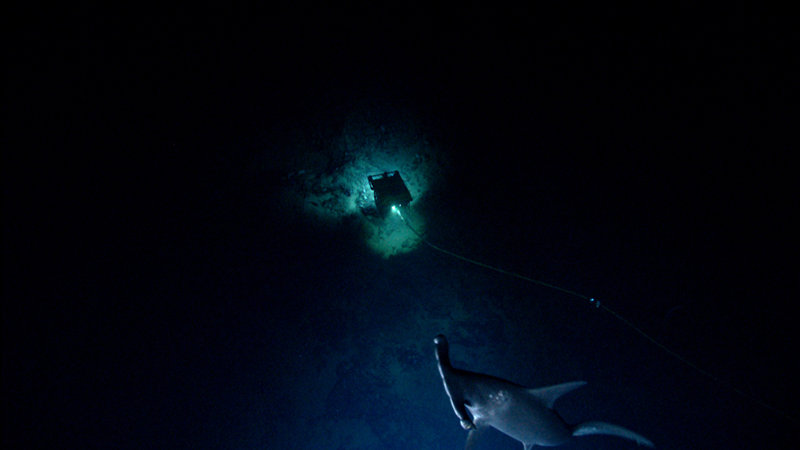
Hammerhead shark investigating the two-body ROV system. Image captured by the Little Hercules ROV at 600 meters depth on the Paramount seamounts on July 14, 2011. Image courtesy of NOAA Office of Ocean Exploration and Research.
Download larger version (jpg, 1.5 MB).

Deep-sea fish, such as this toadfish, have evolved bizarre morphological features as adaptations to this extreme enviroment. Image captured by the Little Hercules ROV at 600 meters depth on the Paramount seamounts on July 14, 2011. Image courtesy of NOAA Office of Ocean Exploration and Research.
Download larger version (jpg, 1.6 MB).
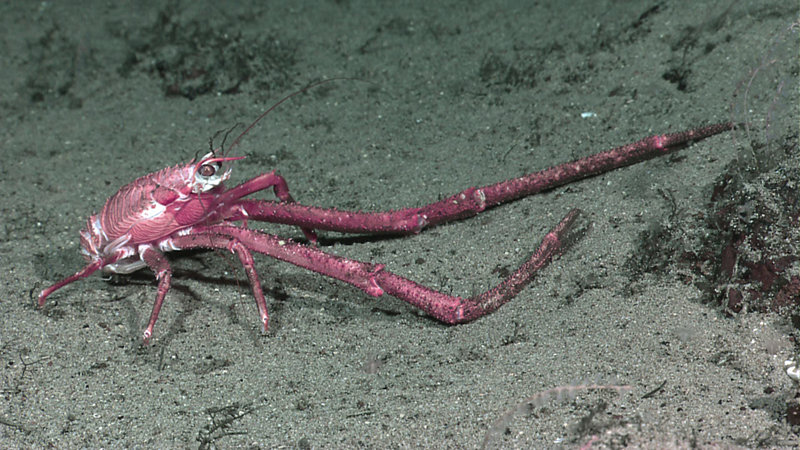
Galatheid squat lobster with extremely enlarged pereiopods . Image captured by the Little Hercules ROV at 600 meters depth on the Paramount seamounts on July 14, 2011. Image courtesy of NOAA Office of Ocean Exploration and Research.
Download larger version (jpg, 1.6 MB).
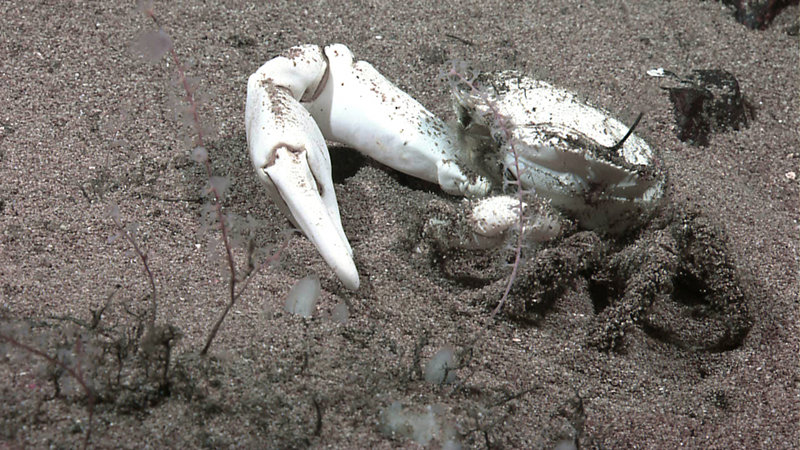
Brachyuran crab half-buried in sediments. Image captured by the Little Hercules ROV at 600 meters depth on the Paramount seamounts on July 14, 2011. Image courtesy of NOAA Office of Ocean Exploration and Research.
Download larger version (jpg, 1.7 MB).
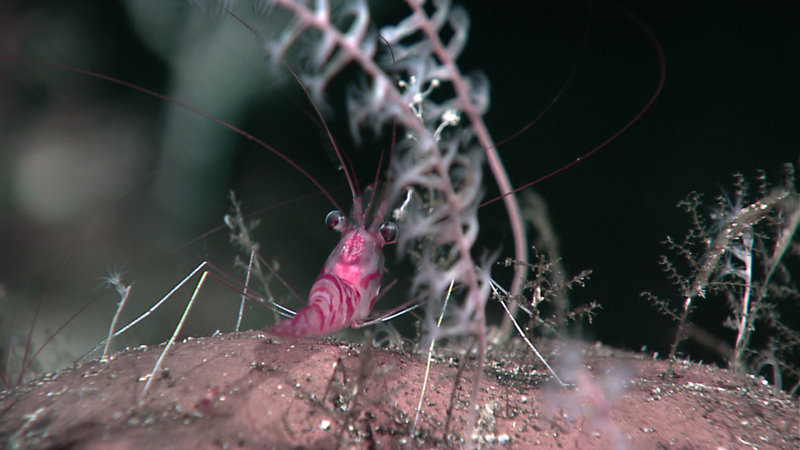
Small colorful shrimp next to octocoral colonies. Image captured by the Little Hercules ROV at 600 meters depth on the Paramount seamounts on July 14, 2011. Image courtesy of NOAA Office of Ocean Exploration and Research.
Download larger version (jpg, 1.2 MB).
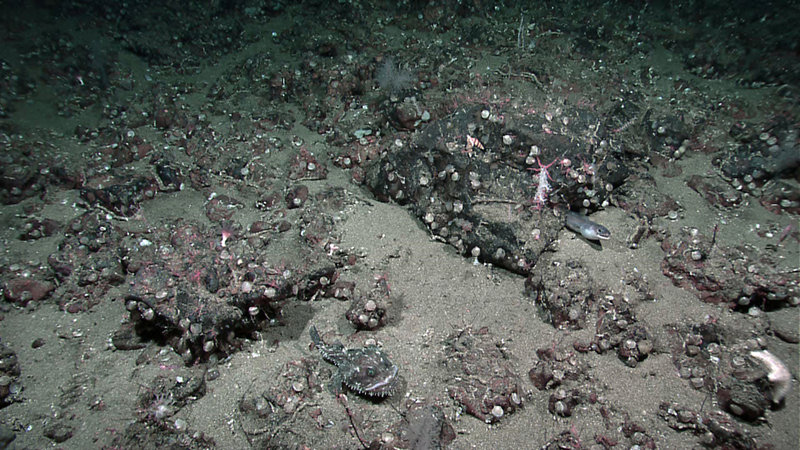
A field of brachiopods and ophiuroids on the seafloor with several fish, corals and a seastar in view. Image captured by the Little Hercules ROV at 600 meters depth on the Paramount seamounts on July 14, 2011. Image courtesy of NOAA Office of Ocean Exploration and Research.
Download larger version (jpg, 1.7 MB).
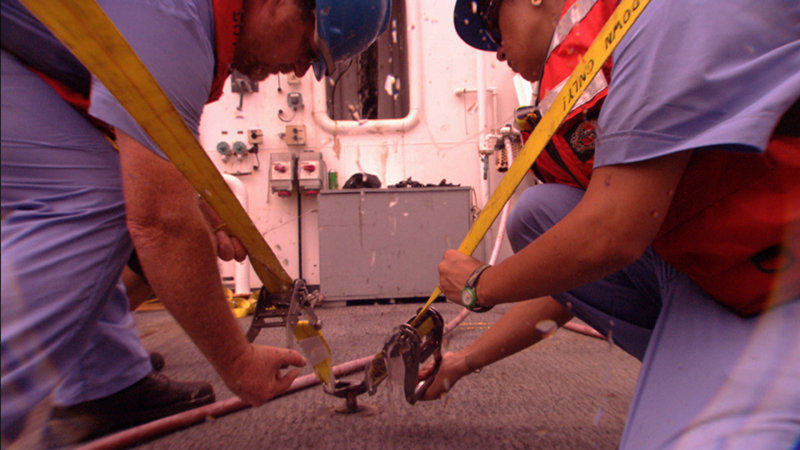
ROV technicians secure Seirios to the EX deck after the Paramount Seamounts dive. Image captured by the Little Hercules ROV at 600 meters depth on the Paramount seamounts on July 14, 2011. Image courtesy of NOAA Office of Ocean Exploration and Research.
Download larger version (jpg, 1.4 MB).
Previous
Next
Seamounts are isolated topographic features found on the seafloor – literally, mountains in the sea – and they provide important hard substrate for colonisation by sessile organisms, such as deep-sea corals, sea-lilies, and sponges, amongst others. Unlike chemosynthetic organisms found on hydrothermal vents, these communities are dependent on the rain-down of suspended organic particles from surface waters for food. Seamounts typically experience accelerated water flows, and as a result, they are an ideal setting for suspension feeders to passively intercept suspended food particles.
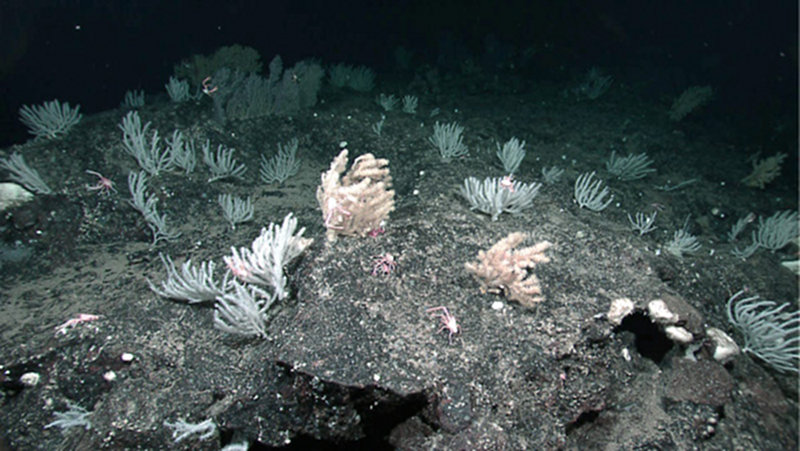
Paramount Seamount at ~800m depth. There was a high abundance, but low diversity of corals (two different morphs of Primnoid corals pictured here) and squat lobsters. Image courtesy of NOAA Office of Ocean Exploration and Research. Download larger version (jpg, 1.5 MB).
The dive started at ~800m. The ROV Little Herc moved upslope and explored the rim of the feature, which probably used to be an island shore a long time ago, before resuming movement towards the summit. Moving upslope, there was an increase in abundance (number of species per unit area) of organisms, and there was a general trend of high abundance of corals, but with low diversity – that is, we were encountering lots of the same species. There was a clear difference in the types of species colonising the summit margin, compared to lower depths, which were separated by a flat area. The summit margin was characterized by a high abundance of white brachiopods (these shelled organisms look superficially like clams, but are actually not at all related) and pink brittle stars. The rocks were a puzzling red color, prompting several hypotheses about their origin. One hypothesis from shore-side scientists was that the rocks are actually fossil shallow-water corals that were formed during a period at which the seamount was above or near the sea surface.
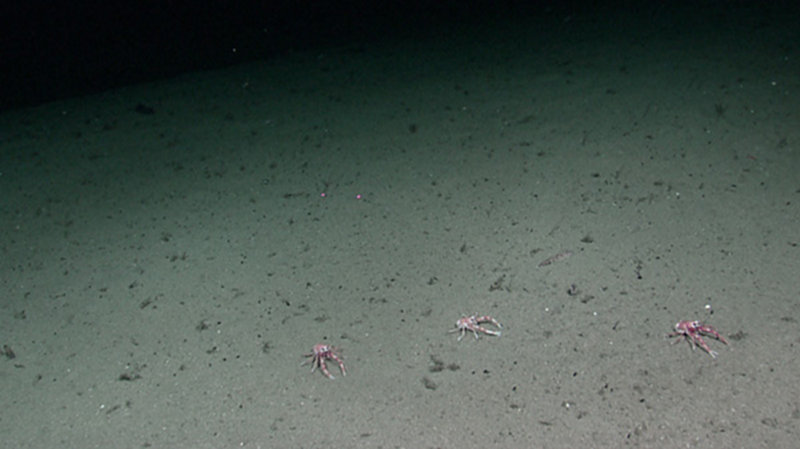
Squat lobsters in the seamount transition zone, a flat area between the rim and the summit cone. The squat lobsters in this area all appeared to face east. Image courtesy of NOAA Office of Ocean Exploration and Research. Download larger version (jpg, 1.1 MB).
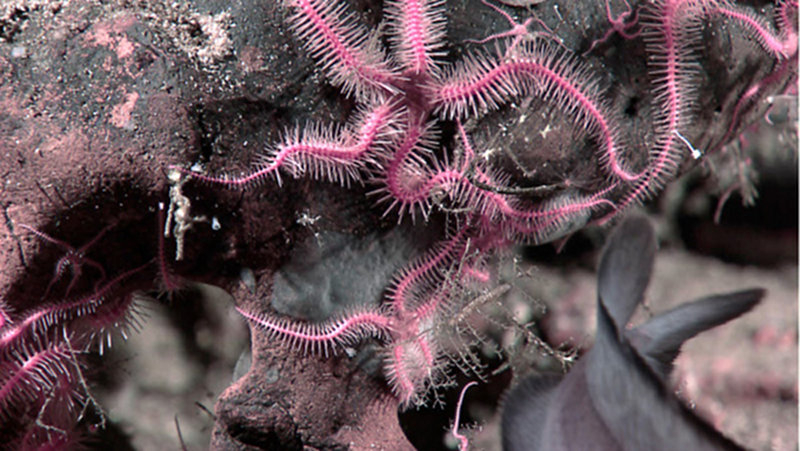
Pink brittle stars in the 400m shallow zone along the summit margin. The brittle stars are on a red substrate, hypothesised to be fossil shallow-water corals. Image courtesy of NOAA Office of Ocean Exploration and Research. Download larger version (jpg, 1.6 MB).
Only limited comparisons may be made between a single seamount from the Galápagos Rift and the many seamounts that were explored during the INDEX-SATAL expedition last year. Nevertheless, for scientists involved in both expeditions, it is hard not to consider how the regions compare. Indonesia, being within the coral triangle, had exceptionally high abundance and diversity of corals, sea-lilies and sponges. These sessile organisms also had a high abundance and diversity of associate fauna living upon them. By contrast, Paramount Seamounts typically had lower diversity and abundance compared to many of the seamounts in the Sangihe Talaud region. One interesting phenomenon was that we encountered a Brachyuran crab carrying some sort of egg case – almost identical to something that we had puzzled over previously in the INDEX-SATAL expedition. We still have much to learn about reproductive strategies in the deep sea.
This one dive on the Paramount Seamounts provided a tantalizing glimpse of the communities and species found in non-hydrothermal settings along the Galápagos Rift.



